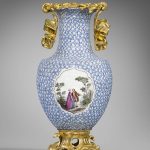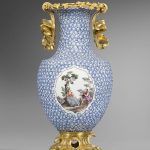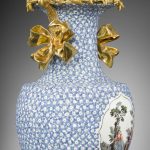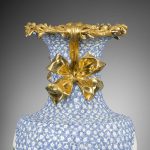A Meissen maïblumen vase
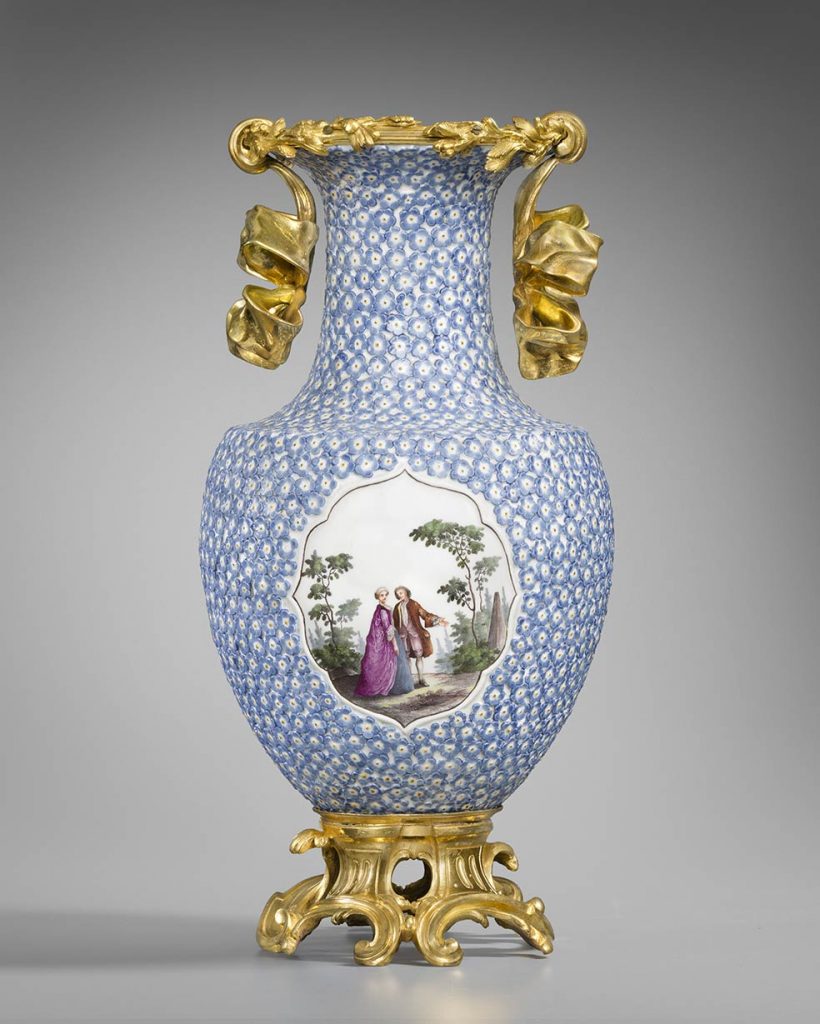
A Louis XV gilt bronze-mounted Meissen maïblumen vase – circa 1745-1749
The Meissen porcelain circa 1745-1750, the mounts struck with the crowned ‘C’ poinçon (1745-1749)
Height: 35.5 cm. (14 in.) Width: 17 cm. (6 ¾ in)
Decorated with ogee-shaped panelled reserves, painted with scenes after Jean-Antoine Watteau (1684-1721), with figures making music, courting and promenading in parks, on a maïblumen ground of forget-me-nots in relief with small blue and yellow flowers.
Provenance
Sold Tajan, Paris, 9 May 2001, lot 35
Comparatve Literature
F.J.B. Watson, The Wrightsman Collection, vol. II, New York, 1966, pp. 474-475, no. 267 A-B.
P.Kjellberg, Objets montés du Moyen Âge à nos jours, Paris, 2000, p. 75.
S.M. Bennett and C. Sargentson, French Art of the Eighteenth century at the Huntington, 2008, pp. 160-161, no. 56.
S.Castelluccio, ‘Le commerce des porcelaines de Saxe et de Chantilly au XVIIIe siècle’, in La Fabrique de l’extravagance. Porcelaines de Meissen et de Chantilly, St-Remy-en-l’Eau, 2020, pp. 214-227.
This type of Meissen porcelain with a raised forget-me-not background is known as maïblumen. Here, a maïblumen vase has been richly mounted in Paris for a sophisticated French clientele.
As Meissen’s production advanced, porcelaine de Saxe as it became known in France became increasingly popular and French dealers developed the import business to satisfy this demand. The ceramic trade in Paris was shared between the corporations of marchands-merciers and faïenciers. In 1732, the faïencier Jean-Charles Huet secured a monopoly over the import of Meissen porcelain. This was soon challenged by his rival Henri Le Brun. Though Huet remained one of the main importers of Meissen, he shared the field with other French customers who appear in the accounts of the manufactory from the 1740s (Castelluccio, op. cit., pp. 215-216).
Rather than buying blindly, these men would specify the forms they wished to obtain by sending designs and models to Dresden. This practice, first established in China for commissioning porcelain for export, made it possible to obtain pieces adapted to the taste of the Parisian market. The faïencier Gilles Bazin for example sent watercolour drawings from 1742, and various other French designs dated in the 1750s and 60s exist in the archives of the Meissen factory (op. cit., p. 217).
Vases of these forms are an illustration of this. They were clearly produced at Meissen exclusively for mounting in France, as in each case the porcelain is intact and not cut down or adapted which is often the case with Asian ceramics. Virtually all surviving examples are fitted with similar elaborate rococo gilt bronze mounts, indicating they were likely specific requests by faïenciers or marchands-merciers to the Meissen factory.
The reserves painted with scenes after Watteau are almost certainly inspired by the Recueil Jullienne and specifically the series of figures de différents caractères, which by the late 1730s were available individually and clearly in use at Meissen.
They proved to be enormously popular with an elite Parisian clientele; examples are documented amongst the collections assembled by the court banker Nicolas Beaujon and Louis XV’s maîtresse-en-titre Madame de Pompadour. The marchand-mercier, Lazare Duvaux’s celebrated Livre-Journal records a sale of these types of Meissen vases to her on 1 September 1750:
« Un pot-pourri de Saxe peints de sujets de Watteau, garni en bronze doré d’or moulu pour 120 livres »
(A Meissen potpourri painted with Watteau subjects, embellished with gilt bronze, for 120 pounds)
followed on 3 June 1752 for the library of her château de Crécy:
« Quatre vases égaux de porcelaine de Saxe à fleurs de relief, avec des cartouches de miniatures, montés en bronze doré d’or moulu, à 475 livres, 1900 livres. Un autre vase, même porcelaine, 520 livres »
(“Four vases equally of Meissen porcelain with floral reliefs and cartouches containing miniatures, mounted in gilt bronze, at 475 pounds [each, totalling] 1900 pounds. Another vase, in the same porcelain, 520 pounds”)
Vases of this type with similar mounts are found in several important public and private collections:

